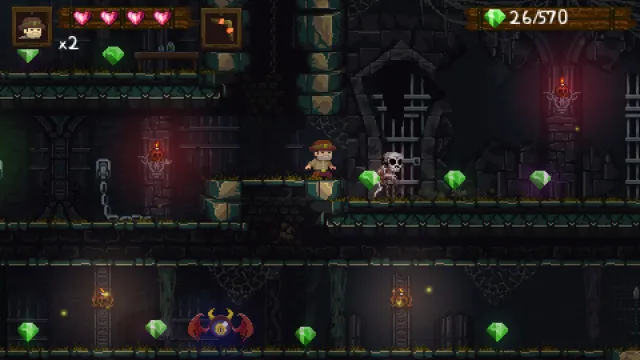
Platforms: PlayStation 5, Nintendo Switch, PlayStation 4, Xbox One
Initial release date: January 30, 2024
Genres: Platform game, Shooter game
Developer: 7 Raven Studios
Publishers: 7 Raven Studios, Totalconsole LLC
There is an inescapably familiar quality to Teppo. Maybe it’s just that he has the general appearance of an adventurer (no, I’m not referring to Indiana Jones), but I feel like I’ve seen him in other video games. In any case, you’ll know exactly what to expect from Teppo and The Hidden Ancient City, just like from the main character.
Now all united at the rear. It’s a platformer with a retro feel! To be honest, I’ve run out of ways to explain these games because there are so many of them available right now. Teppo and The Hidden Ancient City is a short story that should take you a few hours to complete. Nevertheless, considering the affordable price, this is about appropriate.

Is that you, Indy?
There are five levels in all, and they are located in various biomes. Even with a fresh color scheme and a few extra foes thrown in for good measure, each feels identical to the last despite the attempts to stand apart. This is a good representation of Teppo’s and The Hidden Ancient City’s overall appearance. It’s nothing exceptional, maybe because I’m becoming a little tired of this style choice. It’s been exhausted.
But the main menu, which appears to have been covered in a pixelated filter, isn’t going to take home any prizes any time soon. Fortunately, this is the only place where this style option is used; it looks terrible everywhere else. Not the best beginning impression. Despite its limitations, the soundtrack isn’t too awful, which is excellent news. It will quickly circle back around, but since it’s so catchy, you shouldn’t get too worked up over it.
The man himself, Teppo, is a simple guy who can throw bombs, use a boomerang, double jump, and shoot a rifle. That’s all there is to the platforming; however, you have to find the weaponry as you go. Yet, a little tutorial segment at the beginning will give you some practice right away.
For a platformer, each level is fairly large and divided by stone doors. There are concealed switches all over, but they don’t unlock doors in a straight line. Though some backtracking is required, it’s not at all like in a Metroidvania game. To be fair, they are more enjoyable than just navigating your screen from left to right because they are well-mapped out.

There are a few respectably sized levels
Additionally, several hundred diamond stones need to be gathered. The drawback is that in order to open the exit portal, you must achieve a specific percentage. Naturally, obtaining every Gamerscore offers further benefits. In certain stages, I was able to gather even more than the entire quantity shown on the screen, and there is a target amount to reach in order to finish the level. Though I wasn’t completely sure how, I still achieved my goals, so whatever.
What’s more intriguing is that opponents can only be momentarily stunned rather than killed. Like a well-known moustached hero, you can leap on their head or utilize your weaponry. Until you move away from them, they will stay in this state; after that, they will respawn and carry on with their evil activities.
You can take multiple strikes before losing a life, and you begin with an ample number of lives. There are also hearts and 1UPs strewn across the levels. Fortunately, there are save spots as well, however the distribution of them seems erratic. These let you to keep your progress even if you run out of lives and reach the “Game Over” screen. But in the event that this occurs, you will only have one life left. I was prepared to have to restart the game from scratch, but with an unlimited number of lives, considering how long it was. Although the later stages do provide a slight increase in difficulty, this selection still seems strange.
When it comes to difficulty, Teppo and The Hidden Ancient City employ a few cunning techniques that may seem unjust. I was taken off guard by falling blocks and spikes, partly because to the dull visuals, and thus did not have enough time to react. Or rotating traps would appear out of nowhere, right before they gave me a hard blow to the skull. Perhaps it was just my eyes, but I became frustrated in the end. The fact that Teppo doesn’t seem to be able to jump as fast as I was pushing buttons is another irritation. He would bolt if I reacted too late and pressed the leap button when perched precariously on a precipice. It dawned on me instantly that I should have reacted sooner, but it’s challenging when danger strikes with little or no notice.

Kellys!
Though they resemble Donkey Kong Country a lot, the few minecart sequences that are included to break up the levels are entertaining. If not, the first and last boss encounter in the game awaits you at the end: big nasty Tanaca Wanax. However, this is a rather straightforward confrontation in which you must strike him with your weapons while dodging the demons he sends. Although he is shielded by a ring of diamond stones, it appears that he only takes damage at specific points in his movement pattern because I repeatedly landed direct strikes while he was moving without getting any kind of response. Considering how much of a menace the opening scroll of text painted him as, it felt a little cheesy and unsatisfying.
To be honest, I couldn’t get rid of this overarching feeling when seeing Teppo and The Hidden Ancient City. Regretfully, the complex story writes a check that it is unable to fully cash. Although the setup sounds fantastic, it doesn’t really affect how the game plays out for you. It’s a numerical platformer with elements borrowed from genre mainstays, and every rhythm is predictable.
Review Overview
Gameplay – 78%
Story – 82%
Aesthetics – 85%
Content – 80%
Accessibility – 75%
Value – 80%
Overall Rating – 80%
Good
Summary: Teppo and The Hidden Ancient City is a mediocre platformer that doesn’t accomplish anything particularly wrong but falls short of being exceptional.
